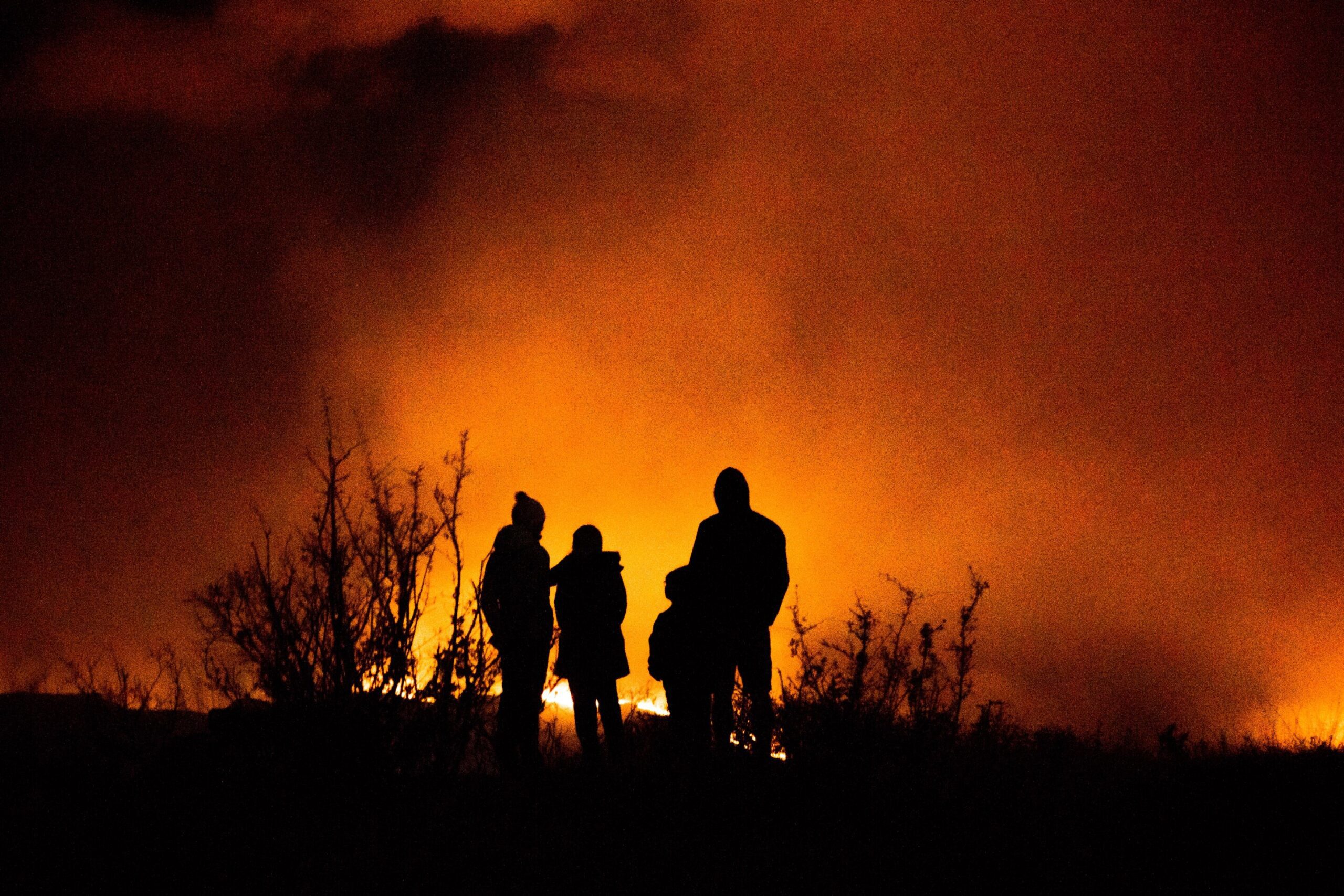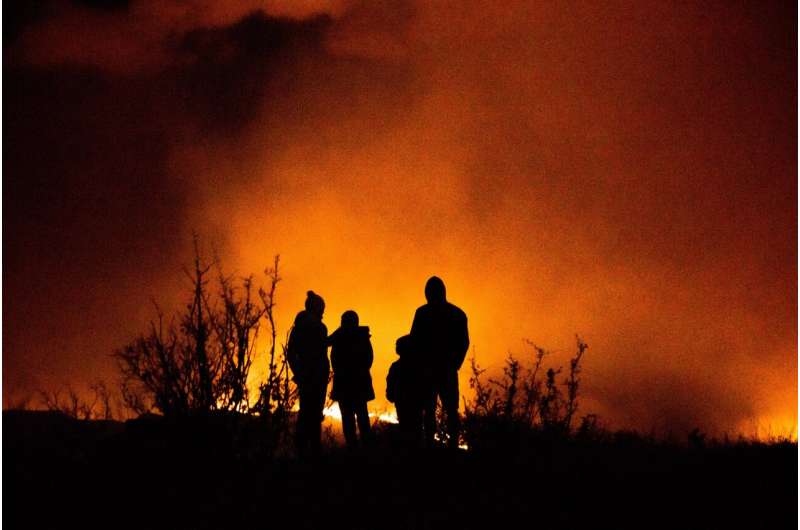

Harlene Schwander didn’t need a second warning from firefighters as a blaze burned toward her home in Klamath River, California, in July.
Schwander told the Associated Press she only had time to grab a few prized possessions before fleeing. “I left everything,” the artist said, including her art collection.
Dubbed the McKinney Fire, it killed four people and burned down a community center and tavern, among other homes and businesses.
In Panama City, Florida, in March, Paul and Laurie Shuman watched glimpses of their home go up in flames through security video on his phone as a wildfire burned into their neighborhood. It was the second time they’d lost a home. Hurricane Michael destroyed the first in 2018.
These two fires on opposite sides of the country are among 64,835 wildfires reported in the nation this year, as of Dec. 9, the most since 2017. Combined the fires burned more than 7.4 million acres. That’s higher than the 10-year average in both number of fires and acres burned. The 10-year average as of Dec. 9 was 54,091 fires and 7.1 million acres burned.
Scientists widely expect conditions to worsen in coming decades, the result of a combination of factors, including the warming climate, intense droughts, storms, forests laden with trees downed by hurricanes, urbanization and conflicts over how to manage land to prevent extreme fires.
US fire season 2022 above average, but not as dire as predicted
Meteorologists already see more more forecasts for above normal fire potential than they did 20 years ago, said Jim Wallmann, a meteorologist at the interagency fire center, and this year was no different.
The early season outlook in March was dire. As bad as things were in some areas, Wallmann said, the year could have been worse.
Unexpected wet weather arriving sooner than normal helped curb bad fire seasons in New Mexico and Alaska. Fire season ramped up quickly in Alaska, burning 3 million acres, more than twice the normal, he said, but a wetter than expected summer brought a quick end to their season.
A generally wetter than normal spring benefited the Northwest and Northern Rockies, he said, while conditions in the Central and Southern Plains were more active than normal.
Climate change is making fire season worse
Over the past five years, wildfires have torched more than 38 million acres across the country, destroying thousands of homes and structures. Federal officials say extremes in drought and heat, fueled by climate change, are drying out forests in the west and Alaska and are the leading driver of an increase in fire weather.
In Alaska, wildfires are a natural part of the landscape in boreal forests and tundra, but the U.S. Department of Agriculture said the changes are bringing much larger, more frequent and more severe wildfires. It’s shifting some forests from spruce trees to deciduous trees and thawing landscapes that increase the risk of drought and wildfires. By 2050, burned areas could increase dramatically as temperatures rise and snow seasons get shorter.
In northern California in 2021, the Dixie Fire became the largest single wildfire in state history, burning about million acres and more than 700 homes.
At times, its flames raced across the landscape at speeds at or beyond what fire behavior models could predict, said Jason Moghaddas, a professional forester with Spatial Informatics Group, who lost his own home to the fire. “When the wind picked up and pushed these fires, they were moving.”
Firefighters say a noticeable shift has taken place over the past decade to fire behavior “they’ve never seen before.”
Predicting fire behavior is getting harder
Wildfires are “regularly behaving in extreme manners” that fire behavior models don’t capture, said Matthew Hurteau, professor and forest and fire ecologist at the University of New Mexico.
The fire models underestimate how dry conditions are, in part because conditions are hitting levels not previously projected until 2050, said Charles Maxwell, a research associate at Oregon State University. “When we start getting these juiced up droughts that are outside of historical conditions and aren’t in any of these future climate projections, that’s when things start to go out the window.”
Fueled by drought and warming temperatures, trees and forest debris are drier than ever and ready to burn more intensely, said Taro Pusina, a fire behavior analyst with Spatial Informatics, a California-based environmental think tank. Flames pick up and run faster. Fires burn hotter and longer.
A century of fire suppression—stopping fires and not allowing them to burn further—adds to the hazards, said Pusina, a U.S. Forest Service retiree who still consults on fires. Forest floors are stacked with decades of needle fall and dead limbs.
What’s next? Renewed attention on prescribed burns
Decades of research show an intentionally set, carefully planned and managed prescribed fire can reduce the risk of catastrophic wildfires. It can reduce debris buildup in forests, add nutrients to the landscape, minimize pests, improve wildlife habitat and promote wildflower blooming.
More than 99.8% of all prescribed fires go according to plan, the forest service has said.
But when they don’t, the consequences can be catastrophic.
That was illustrated by the Hermits Peak fire in New Mexico this year. A prescribed fire set by forest service staff in April escaped its containment lines and became the largest fire in state history, torching 341,000 acres and nearly 900 homes.
A review found human error partly to blame, in addition to drier than expected conditions. Randy Moore, the forest service chief, imposed a 90-day burn ban and put together a review task force of more than a half-dozen experts from inside and outside the agency.
The task force looked at contributing factors in previous escaped burns, including pressure to complete the critical work, which had been stymied by things like furloughs and the pandemic; lack of resources and weather information; gaps in communication and inadequate information about the impacts of drought on fire conditions.
Its 107-page report, released in September, concluded prescribed burning is key to reducing “the risk of catastrophic fire” but that certain steps would make it safer and more effective.
Steps to safer burning
The task force made three kinds of recommendations:
- Immediate changes to make burning safer and more effective
- Near-term changes to improve the fire program
- Items for longer-term study
Moore announced the agency would make a suite of changes and resume burning once the findings and recommendations had been reviewed with all employees involved in prescribed burning. The changes include:
- Issuing burn permits only for a 24-hour window
- More complete scientific analysis of burn plans, making sure they reflect current conditions
- Requiring the “burn boss” to document conditions and assess any human factors, such as fatigue and experience of those setting the blaze.
- Develop a national prescribed fire strategic plan by Dec.15
- Develop a western prescribed fire training curriculum by Jan. 1
Many other agencies, universities and other groups also are working toward improving fire fighting, prescribed burning and wildfire resilience.
Moghaddas, Pusina and Hurteau are members of Pyregence, a national consortium of experts. Representing 18 institutions, its four working groups are tackling improvement of weather observations and communications and development of fire modeling and prediction tools to advance fire science.
Kansas Governor Laura Kelly created a state wildfire task force in July.
California has taken strides to curtail wildfires and reports it has allocated $2.8 billion toward becoming more fire resilient. As fires raged in the state in 2020, Governor Gavin Newsom called it “a climate damn emergency.”
(c)2022 USA Today
Distributed by Tribune Content Agency, LLC.
Citation:
Another above-average wildfire season for 2022. How climate change is making fires harder to predict and fight. (2022, December 27)
retrieved 27 December 2022
from https://phys.org/news/2022-12-above-average-wildfire-season-climate-harder.html
This document is subject to copyright. Apart from any fair dealing for the purpose of private study or research, no
part may be reproduced without the written permission. The content is provided for information purposes only.